Hand-Scraped Wood Floors: Trendy and Timeless
 When you're thinking about floor coverings, wood flooring stands out from the crowd for its natural good looks. Often the most desirable way to show off the beautiful grain and patterning is by installing a smooth hardwood floor with a high gloss finish. But if sleek and shiny are not quite you, there is an alternative that just might suit your personal style to a T. Hand-scraped wood floors are trending now ... though ironically they draw on a time-honored technique.
When you're thinking about floor coverings, wood flooring stands out from the crowd for its natural good looks. Often the most desirable way to show off the beautiful grain and patterning is by installing a smooth hardwood floor with a high gloss finish. But if sleek and shiny are not quite you, there is an alternative that just might suit your personal style to a T. Hand-scraped wood floors are trending now ... though ironically they draw on a time-honored technique.
How Are Hand-Scraped Floors Produced?
Hand-scraped wood floors are also known as hand-sculptured. They have a rugged, handcrafted look, based on the pre-industrial method of smoothing wooden planks. In the past, prior to installation of a hardwood floor, woodworkers would scrape the lumber by hand, with the help of a tool called a drawknife. The process left a surface that was even, but still had visible scrape marks. (The many fans of hand-scraped flooring feel that these marks add charm and individuality.) Nowadays this work is often still performed in the long-established manner by skilled craftspeople, who might texture the wood further by careful denting, roughening, sanding, or scooping. However, contemporary "hand-scraping" may also be produced with the help of machinery, usually equipped with wire brushes to give a distressed look.
What Are Hand-Scraped Floors Made of?
Any type of hardwood suitable for use as flooring can be enhanced with scraping. Popular species for hand-scraped floors include birch, cherry, elm, hickory, maple, oak, and walnut. In addition to the traditional hardwoods, these days other materials may be hand scraped as well. The most common are engineered wood and sustainable bamboo. Even laminate and vinyl flooring can be designed with an uneven "hand-scraped" look. Whatever the material, it's possible for the degree of treatment to range from light to heavy, allowing you to choose the style that will best complement your home's decor. Hand-scraped floors are finished in either matte or low to medium gloss -- or even painted if that is what you prefer.
Advantages
Let's face it, wood floors look wonderful … when they're brand new. However, smooth and glassy high-gloss finishes tend not to stand up to wear and tear. If you have children and/or pets and don't want to have to worry about every little scratch or ding, hand-scraped flooring is a great choice for you, as it will retain its handsome appearance for decades. Cleaning is simpler as well; dust, debris, and animal hair are much less visible on this flooring's uneven surface. The grooves are shallow enough that it is easy to run a broom or damp mop over them.
In terms of aesthetics, hand-scraped floors look strikingly attractive in the right setting. They are the perfect finishing touch if you plan to restore a period house or display a collection of vintage furnishings, and they will add character and interest to a more modern home. (The only time when hand-scraped wood tends to look out of place is in a very formal or ultra-modern environment.)
Disadvantages
Hand-scraped hardwood floors are harder to refinish than smooth ones. The main problem is that sanding is more time-consuming since you are not working with a flat surface. (Hand-scraped flooring is not likely to need frequent refinishing, though.) Another disadvantage is that hand-scraped is somewhat more expensive than standard hardwood. A final issue to keep in mind is some homeowners' concern that the current popularity of hand-scraped hardwood could be just a passing fancy. This may well be true of the most heavily distressed versions, especially if they are finished in a faddishly dark hue. For a look which will add to your home's resale value and give you pleasure for many years, select a subtle mid-tone with only moderate distressing.
Laura Firszt writes for networx.com.
Updated April 10, 2018.
Looking for a Pro? Call us (866) 441-6648

Flooring Average Costs
Flooring Contractors Experiences

How I Chose My Flooring Contractor And Why I’m Glad I Did

Look To Independent Contractors For Fast Service And Good Prices



